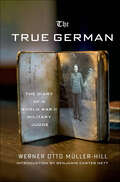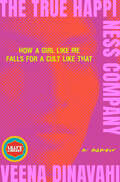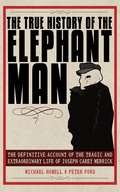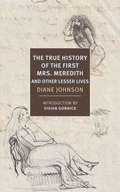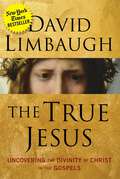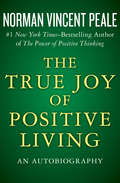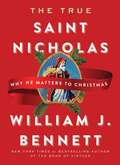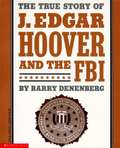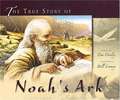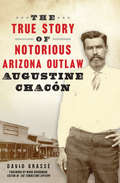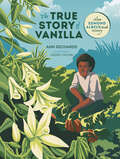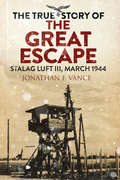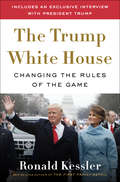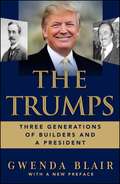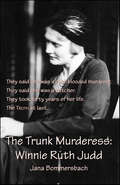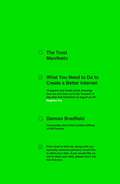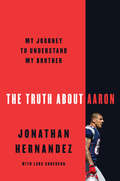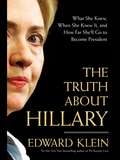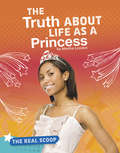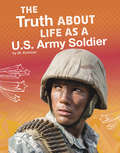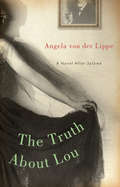- Table View
- List View
The True German: The Diary of a World War II Military Judge
by Werner Otto Müller-HillA recently discovered diary held by a German military judge from 1944 to 1945 sheds new light on anti-Hitler sentiments inside the German army.Werner Otto Müller-Hill served as a military judge in the Werhmacht during World War II. From March 1944 to the summer of 1945, he kept a diary, recording his impressions of what transpired around him as Germany hurtled into destruction—what he thought about the fate of the Jewish people, the danger from the Bolshevik East once an Allied victory was imminent, his longing for his home and family and, throughout it, a relentless disdain and hatred for the man who dragged his beloved Germany into this cataclysm, Adolf Hitler and the Nazi party. Müller-Hill calls himself a German nationalist, the true Prussian idealist who was there before Hitler and would be there after. Published in Germany and France, Müller-Hill's diary The True German has been hailed as a unique document, praised for its singular candor and uncommon insight into what the German army was like on the inside. It is an extraordinary testament to a part of Germany's people that historians are only now starting to acknowledge and fills a gap in our knowledge of WWII.
The True Happiness Company: A Memoir
by Veena DinavahiIn this darkly humorous and wrenchingly sincere memoir, a young Indian American woman&’s dreams of being a well-adjusted college student get wildly derailed when her struggles with mental health land her in the office of a charismatic alternative therapist and his self-help cult.&“Honest, brutal, funny, fascinating. A vital reminder of how important it is to trust ourselves.&”—Jenny Lawson, New York Times bestselling author of Let&’s Pretend This Never Happened and Furiously Happy&“Veena Dinavahi is a ferocious writer with a poetic left hook.&”—Bethany Joy Lopez, New York Times bestselling author of Dinner for VampiresIt is hard for Veena Dinavahi to live while her classmates keep dying. The high-achieving daughter of loving Indian immigrants, Veena lives in a typical white American suburb—except for its unusually high suicide rate. For years, she tries to manage her mental health in all the right ways, but nothing seems to work. Until, on a late-night Google search, Veena&’s mom discovers Bob Lyon—a sixty-year-old white man in the backwoods of Georgia who claims he can make her want to live again. He calls himself &“The True Happiness Company&” and, as their relationship progresses, &“Daddy.&” Veena becomes increasingly enveloped in his strangely close-knit community, and before she knows it, she&’s a college dropout, married mother of three, and Mormon convert who has gotten way too good at dismissing her gut feeling that something is wrong. But when Veena&’s treatment goes too far, she slowly begins to question whether true happiness can even exist as an absolute.In this revelatory debut, Veena traces the contours of her life to explore the question that plagued her in the years afterward: how did I fall for that? And what will it mean to move forward?Told with unflinching clarity and shot through with incisive wit, The True Happiness Company is Veena Dinavahi&’s singular exploration of what it means to lose and reclaim your identity, rethink mental illness, and learn to trust your intuition in a world determined to annihilate it.
The True History of Merlin the Magician
by Anne Lawrence-MathersA medieval historian examines what we really know about the man who was &“Merlin the Magician&” and his impact on Britain. Merlin has remained an enthralling and curious individual since he was first introduced in the twelfth century in Geoffrey of Monmouth&’s Historia Regum Britanniae. But although the Merlin of literature and Arthurian myth is well known, his &“historical&” figure and his relation to medieval magic are less familiar. In this book Anne Lawrence-Mathers explores just who he was and what he has meant to Britain.The historical Merlin was no rough magician: he was a learned figure from the cutting edge of medieval science and adept in astrology, cosmology, prophecy, and natural magic, as well as being a seer and a proto-alchemist. His powers were convincingly real—and useful, for they helped to add credibility to the &“long-lost&” history of Britain which first revealed them to a European public. Merlin&’s prophecies reassuringly foretold Britain&’s path, establishing an ancient ancestral line and linking biblical prophecy with more recent times. Merlin helped to put British history into world history.Lawrence-Mathers also explores the meaning of Merlin&’s magic across the centuries, arguing that he embodied ancient Christian and pagan magical traditions, recreated for a medieval court and shaped to fit a new moral framework. Linking Merlin&’s reality and power with the culture of the Middle Ages, this remarkable book reveals the true impact of the most famous magician of all time.&“The story of how the image of Merlin as political prophet, magician and half-demon evolved in the Middle Ages is as fascinating as any romance.&”—Euan Cameron
The True History of the Elephant Man: The Definitive Account of the Tragic and Extraordinary Life of Joseph Carey Merrick
by Peter Ford Michael HowellDue to horrible physical deformities, he spent much of his life as a fair-ground freak. He was hounded, persecuted, and starving, until his fortune changed and he was rescued, housed, and fed by the distinguished surgeon, Frederick Treves. The subject of several books, a Broadway hit, and a film, Joseph Merrick has become part of popular mythology. Here, in this fully revised edition containing much fresh information, are the true and unromanticized facts of his life.
The True History of the First Mrs. Meredith and Other Lesser Lives
by Diane JohnsonA classic of alternative biography and feminist writing, this empathetic and witty book gives due to a "lesser" figure of history, Mary Ellen Peacock Meredith, who was brilliant, unconventional, and at odds with the constraints of Victorian life.&“Many people have described the Famous Writer presiding at his dinner table. . . . He is famous; everybody remembers his remarks. . . . We forget that there were other family members at the table—a quiet person, now muffled by time, shadowy, whose heart pounded with love, perhaps, or rage.&” So begins The True History of the First Mrs. Meredith and Other Lesser Lives, an uncommon biography devoted to one of those &“lesser lives.&” As the author points out, &“A lesser life does not seem lesser to the person who leads one.&” Such sympathy and curiosity compelled Diane Johnson to research Mary Ellen Peacock Meredith (1821–1861), the daughter of the famous artist Thomas Love Peacock (1785–1866) and first wife of the equally famous poet George Meredith (1828–1909). Her life, treated perfunctorily and prudishly in biographies of Peacock or Meredith, is here exquisitely and unhurriedly given its due. What emerges is the portrait of a brilliant, well-educated woman, raised unconventionally by her father only to feel more forcefully the constraints of the Victorian era. First published in 1972, Lesser Lives has been a key text for feminists and biographers alike, a book that reimagined what biography might be, both in terms of subject and style. Biographies of other &“lesser&” lives have since followed in its footsteps, but few have the wit, elegance, and empathy of Johnson&’s seminal work.
The True Jesus: Uncovering the Divinity of Christ in the Gospels
by David Limbaugh<P>"Who do you say that I am?" <P>Uttered by Jesus Christ, this profound question has presented an age-old challenge to believers, skeptics, scholars, and rulers. <P>In attempting to answer this question, The True Jesus goes straight to the unimpeachable source: the books of Matthew, Mark, Luke, and John. Only in the Gospels, says #1 New York Times bestselling author David Limbaugh, do we come face-to-face with the Son of God, Whose sublime teachings, miraculous actions, and divine essence leap off every page and into our hearts. <P>In this book, Limbaugh combines the four Gospel stories into a unified account (though not, he humbly admits, a perfect harmony) and guides readers on a faith journey through the Four Evangelists' testimonies of the life of Jesus Christ. Along the way, Limbaugh shares his insights on Jesus' words and deeds as well as His unique nature as fully human and fully divine. In The True Jesus, you will learn: <br>- Why even the apostles failed to completely understand Jesus' true identity and mission until after His crucifixion <br>- The real basis for the rejection of Jesus' message by skeptics in His hometown and elsewhere <br>- The historical events preceding Jesus' birth that providentially paved the way for Christianity <br>- How Jesus' message utterly contradicted modern attempts to portray Him as being non-judgmental <P>Limbaugh's passion for the Gospels infuses the pages of The True Jesus, which is both a primer for new Bible readers and an outstanding guide to the Gospels for long-time believers. Who really is the true Jesus? Open this book and begin your odyssey toward the answer. <P><b>A New York Times Bestseller</b>
The True Joy of Positive Living: An Autobiography
by Norman Vincent PealeThe inspiring autobiography of the world-renowned minister and revered self-help giant whose positive thinking techniques have bettered the lives of millions of people In his 95 years, Norman Vincent Peale made a profound difference. The son of a minister in Lynchburg, Ohio, he went on to preach the Lord's word at Manhattan's now-famous Marble Collegiate Church, where he served as pastor for 52 years and oversaw the church's growth from 600 members to more than 5,000. He had a popular radio program for more than half a century, and appeared regularly on television. But perhaps his most lasting and powerful contribution was as author of the mega-bestseller The Power of Positive Thinking, the groundbreaking book that provided new guidance and hope and changed countless lives for generations throughout the world. The True Joy of Positive Living is the inspiring true story of a humble man who started out poor in a small Midwestern town and rose to become one of the most famous and influential American figures of the 20th century--a man of God who was awarded the Presidential Medal of Freedom, the country's highest civilian honor, by President Ronald Reagan in 1984. Together with this wife Ruth, Dr. Peale founded the Peale Center for Christian Living and Guideposts magazine to ensure that his messages of self-confidence and the power of faith would continue to guide millions around the world even after his death. In his own uplifting words, Dr. Peale shares the story of a remarkable life lived with dignity and purpose. This stirring chronicle of an extraordinary soul--his unwavering service to the Lord and his remarkable development of the principles of positivity that had a life-altering effect on so many--will be an inspiration to all who read it.
The True Saint Nicholas: Why He Matters to Christmas
by William J. BennettIf you've ever been asked, "Who is Saint Nicholas?". . . If you've ever wondered if he is just a commercial invention. . . If you've ever thought there is no such person. . . You may be surprised to know the true Saint Nicholas. You'll never again think of Santa Claus in quite the same way. An instant classic by one of America's most respected thinkers, The True Saint Nicholas is a book to be shared with family and friends every year to evoke the true spirit of Christmas.
The True Saint Nicholas: Why He Matters to Christmas
by William J. BennettFormer secretary of education and New York Times bestselling author William Bennett blends his historical expertise with his gift for storytelling into a heartwarming book about the man who ultimately became known as Santa Claus.Beloved writer and speaker William Bennett brings the legendary Saint Nicholas to life in this fascinating and faith-affirming book that will change the way you think about Santa Claus and the meaning of Christmas. Bennett reflects on Saint Nicholas&’s storied life, which has spanned seventeen centuries across Europe, Asia, and Africa, and reveals an inspiring tale of devotion to God and an example of eternal goodness. The True Saint Nicholas: Why He Matters to Christmas focuses on three aspects of Saint Nicholas—historical facts from his life, his legacy in the centuries following his death, and the legendary status that transformed his likeness into the present-day jolly, toy-bearing Santa Claus. The book vividly captures the heart and life of someone who lived long ago—and yet whose life remains an inspiration for everyone to aspire to a higher order of generosity, giving, and devotion to others. An instant classic by one of America&’s most respected thinkers, The True Saint Nicholas is a memorable keepsake to be shared with family and friends every year to evoke the true spirit of Christmas.
The True Story of J.Edgar Hoover and the FBI
by Barry DenenbergA biography of the former chief of the Federal Bureau of Investigation, focusing on the FBI's impact on the major law enforcement issues of the 1920s through the early 1970s.
The True Story of Noah's Ark
by Tom DooleyBased on the account of Noah's ark recorded in Genesis 6-9, tells the story of how God asked Noah to build an ark to save Noah's family and representative animals from the flood.
The True Story of Notorious Arizona Outlaw Augustine Chacón (True Crime)
by David GrasséBy the time he was hanged in 1903, Augustine Chacón had become the most notorious Mexican outlaw in the Arizona Territory. His alleged crimes had made him a virtual legend, but the facts show that Chacón wasn't the bloodthirsty fiend he was made out to be. Journalists of the era chased sensationalist stories, pandering to a readership that longed for excitement. Each retelling of Chacón's exploits added outlandish details, painting the escaped prisoner as a brutal gunman responsible for as many as fifty-two murders. In reality, Augustine Chacón may not even have killed the man he was hanged for shooting. Join author David Grassé as he uncovers the true story of Arizona's most enduring criminal legend.
The True Story of Vanilla: How Edmond Albius Made History (Orca Biography)
by Ann RichardsIn 1841, a 12-year-old enslaved boy, Edmond Albius, made history when he discovered how to hand-pollinate vanilla plants using a bamboo twig. Until that time, only bees in Mexico could pollinate the plant—botanists couldn’t figure out another way. With his master, Edmond travelled around Réunion Island to share his technique, le geste d’Edmonde (Edmond’s gesture), which is still in use today. Despite his important achievement, as an enslaved person Edmond didn’t receive payment or recognition for his contribution to science, eventually dying in poverty after being freed from slavery in 1848. Today it is recognized that Edmond’s method of pollination was key to bringing vanilla to the world, helped to create a billion-dollar industry and gave us the flavor we love to use in cooking, baking, medicine and, of course, ice cream. The epub edition of this title is fully accessible.
The True Story of the Great Escape: Stalag Luft III, March 1944
by Simon Pearson Jonathan F. VanceThe real history behind the classic war movie and the men who plotted the daring escape from a Nazi POW camp. Between dusk and dawn on the night of March 24th–25th 1944, a small army of Allied soldiers crawled through tunnels in Germany in a covert operation the likes of which the Third Reich had never seen. The prison break from Stalag Luft III in eastern Germany was the largest of its kind in the Second World War. Seventy-nine Allied soldiers and airmen made it outside the wire—but only three made it outside Nazi Germany. Fifty were executed by the Gestapo. In this book Jonathan Vance tells the incredible story that was made famous by the 1963 film The Great Escape. It is a classic tale of prisoners and their wardens in a battle of wits and wills. The brilliantly conceived escape plan is overshadowed only by the colorful, daring (and sometimes very funny) crew who executed it—literally under the noses of German guards. From the men&’s first days in Stalag Luft III and the forming of bonds among them, to the tunnel building, amazing escape, and eventual capture, Vance&’s history is a vivid, compelling look at one of the greatest &“exfiltration&” missions of all time. &“Shows the variety and depth of the men sent into harm&’s way during World War II, something emphasized by the population of Stalag Luft III. Most of the Allied POWs were flyers, with all the technical, tactical and planning skills that profession requires. Such men are independent thinkers, craving open air and wide-open spaces, which meant that an obsession with escape was almost inevitable.&” —John D. Gresham
The True Story of the Great Escape: Stalag Luft III, March 1944
by Simon Pearson Jonathan F. VanceThe real history behind the classic war movie and the men who plotted the daring escape from a Nazi POW camp. Between dusk and dawn on the night of March 24th–25th 1944, a small army of Allied soldiers crawled through tunnels in Germany in a covert operation the likes of which the Third Reich had never seen. The prison break from Stalag Luft III in eastern Germany was the largest of its kind in the Second World War. Seventy-nine Allied soldiers and airmen made it outside the wire—but only three made it outside Nazi Germany. Fifty were executed by the Gestapo. In this book Jonathan Vance tells the incredible story that was made famous by the 1963 film The Great Escape. It is a classic tale of prisoners and their wardens in a battle of wits and wills. The brilliantly conceived escape plan is overshadowed only by the colorful, daring (and sometimes very funny) crew who executed it—literally under the noses of German guards. From the men&’s first days in Stalag Luft III and the forming of bonds among them, to the tunnel building, amazing escape, and eventual capture, Vance&’s history is a vivid, compelling look at one of the greatest &“exfiltration&” missions of all time. &“Shows the variety and depth of the men sent into harm&’s way during World War II, something emphasized by the population of Stalag Luft III. Most of the Allied POWs were flyers, with all the technical, tactical and planning skills that profession requires. Such men are independent thinkers, craving open air and wide-open spaces, which meant that an obsession with escape was almost inevitable.&” —John D. Gresham
The Trump Tapes: Bob Woodward's Twenty Interviews with President Donald Trump
by Bob Woodward&“An uncharacteristic warning from one of the most respected, non-partisan journalists in the world&” —Jake Tapper, CNN &“It was riveting. I couldn&’t get enough of it.&” —Gayle King, CBS MorningsThe Trump Tapes explodes with the exclusive, inside story of Trump&’s performance as president—in his own words as he is questioned, even interrogated by Woodward, on the president&’s key responsibilities from managing foreign relations to crisis management of the coronavirus pandemic. This is the job Trump seeks again. How did he do the first time? This is the authentic answer, laying bare his repeated failures, obsessions, and grievances. The Woodward interviews take a reader to a reporter&’s laboratory meticulously examining the Trump presidency like never before—spellbinding and devastating. *Including all 27 letters between President Trump and North Korean Leader Kim Jong Un
The Trump White House: Changing the Rules of the Game
by Ronald KesslerThe unvarnished and unbiased inside story of President Donald Trump and his White House by New York Times bestselling author Ronald Kessler Based on exclusive interviews with the president and his staff, The Trump White House: Changing the Rules of the Game tells the real story of what Donald Trump is like, who influences him, how he makes decisions, what he says about the people around him, and how he operates when the television lights go off, while portraying the inside story of the successes that have already brought solid results as well as the stumbles that have turned off even longtime supporters and undercut his agenda.The Trump White House reveals: • Trump aides Ivanka Trump and her husband Jared Kushner have been responsible for Trump’s most disastrous decisions. Trump is aware that his daughter and son-in-law are problems and has hinted to them that they should go back to New York. Seeing Jared on TV, Trump said, “Look at Jared, he looks like a little boy, like a child.” • First Lady Melania Trump has a tremendous impact on policy and strategy. She sits in on meetings and is widely admired by aides for her judgment. • Kellyanne Conway is the No. 1 White House leaker. • Trump’s Secret Service Director Randolph “Tex” Alles proposed withdrawing protection from some Trump family members and aides to save money. Horrified White House staffers shot down the idea. • Trump has told friends that billionaires are constantly asking him to fix them up with longtime Communications Director Hope Hicks, a former model, but he says he refuses. • Trump calls certain reporters directly, feeding them stories attributed to “a senior White House official,” creating the impression that the White House leaks even more than it already does. Never before has an American president had so much impact on the country and the world in so short a time as Donald Trump. Yet no president has stirred so much controversy, dominating media coverage and conversation both pro and con. Months after Trump took office, consumer confidence hit a seventeen-year high, unemployment plummeted to the lowest level in seventeen years, and the stock market zoomed to repeated record highs. At the same time, ISIS was nearly defeated, Arab countries banded together to stop financing terrorists and promoting radical Islamic ideology, and Trump’s decision to send missiles into Syria because of its use of chemical weapons and his strident warnings to North Korean leader Kim Jong-un made it clear to adversaries that they take on the United States at their peril. Yet for all the media coverage, Trump remains a cipher. Ronald Kessler has known Trump and First Lady Melania Trump for two decades and understands him better than any other journalist. The book includes an exclusive interview with Trump, the only interview he says he has given or will give for a book as president. Crammed with media-grabbing revelations. The Trump White House is the unvarnished and unbiased inside story that answers the question: Who is Donald Trump?
The Trumps: Three Generations of Builders and a Presidential Candidate
by Gwenda BlairThe story of three generations of Trumps in a "copiously researched" (The New York Times) narrative and an account of the presidential candidate's extraordinary path to success. "Rich, detailed, and informative, and not just for Trump loyalists or detractors" (Kirkus Reviews, starred review).This richly detailed account of the Trump family reflects America's transformation from a land of striving immigrants to a world in which the aura of wealth alone can guarantee a fortune. The Trumps begins with a portrait of Donald's immigrant grandfather Frederick Trump, a restaurant owner who amassed the first Trump fortune by providing miners with food, liquor, and easy access to women during the Klondike gold rush. His son, Fred, took advantage of New Deal policy, using government subsidies and loopholes to construct hugely successful housing developments in the 1940s and 1950s. The profits from those enterprises paved the way for Donald's roller-coaster ride into the new century. With his talent for what he calls "truthful hyperbole," Donald Trump turned the deal-making know-how of his forebears into an art form. By describing Donald's much-publicized life in the context of his family, Gwenda Blair adds an important dimension to a glitzy, larger-than-life contradictory figure known around the world as The Donald.
The Trunk Murderess: Winnie Ruth Judd
by Jana BommersbachIf history is right, a 26 year-old beauty named Winnie Ruth Judd murdered her two best girlfriends one hot Phoenix night in 1931. Then she hacked up their bodies, stuffed the pieces into a trunk, and took them by train to Los Angeles as her baggage.If history is right, she was sentenced to die but "cheated the gallows" by acting insane. She spent nearly 40 years in Arizona's insane asylum-flummoxing officials by escaping six times.If history is right, she only got her freedom at age 66-after serving more time than any other convicted murderer in the history of the nation—because Arizona was finally tired of punishing her.But if history is wrong, Winnie Ruth Judd's life was squandered in a horrible miscarriage of justice.Award-winning journalist Jana Bommersbach reinvestigates the twisted, bizarre murder case that has captivated the nation for decades. She not only uncovers evidence long hidden, but gets Winnie Ruth Judd to break her life-long silence and finally speak.In telling the story of this American crime legend, Bommersbach also tells the story of Phoenix, Arizona—a backwater town that would become a major American city—and the story of a unique moment in American history filled with social taboos.But most of all, she tells the story of a woman with the courage to survive.
The Trust Manifesto: What you Need to do to Create a Better Internet
by Damian BradfieldFrom the moment we wake up and unlock our phones, we're producing data. We offer up our unique fingerprint to the online world, scan our route to work, listen to a guided meditation or favourite playlist, slide money around, share documents and update our social media accounts. We reach for our phones up to 200 times a day, not knowing which companies are storing, using, selling and manipulating our data. But do we care? We're busy. We've got lives. We're pressed for time! There aren't enough hours in the day to read the terms and conditions. Or, maybe we're happy to trade our personal data for convenient services and to make our lives easier?Big data is the phenomenon of our age, but should we trust it without question? This is the trust dilemma.In 2009, Damian Bradfield founded WeTransfer, the largest file-sharing platform in the world with 50 million global users shipping more than one billion files of data a month. His unique experience of the big data economy has led him to question if there is another way to build the internet, one that is fairer and safer for everyone and, in The Trust Manifesto, he lays out this vision.
The Truth About Aaron: My Journey to Understand My Brother
by Lars Anderson Jonathan HernandezAaron Hernandez’s brother recounts the NFL star’s troubled life and murder conviction: “Gripping . . . a sobering, inside look at a modern American tragedy.” —Library JournalTo football fans, Aaron Hernandez was a superstar in the making. A standout at the University of Florida, he helped the Gators win the national title in 2008. In his second full season wih the New England Patriots, he and Rob Gronkowski set records for touchdowns and yardage, and with Tom Brady, led New England to Super Bowl XLVI in 2012. But Aaron’s NFL career ended as quickly as it began. On June 26, 2013, he was arrested at his North Attleboro home, charged with the murder of Odin Lloyd, and released by the Patriots. Convicted of first-degree murder, Aaron was sentenced to life without parole. On May 15, 2014, while on trial for Lloyd’s murder, Aaron was indicted for two more murders. Five days after being acquitted for those murders, he committed suicide in his jail cell. Aaron Hernandez was twenty-seven years old.In this clear-eyed, emotionally devastating biography—a family memoir combining football and true crime—Jonathan (formerly known by his nickname DJ) Hernandez speaks out fully for the first time about the brother he knew. Jonathan draws on his own recollections as well as thousands of pages of prison letters and other sources to give us a full portrait of a star athlete and troubled young man who would become a murderer, and the darkness that consumed him. Jonathan does not portray Aaron as a victim; he does not lay the blame for his crimes on his illness. He speaks openly about Aaron’s talent, his sexuality, his crimes and incarceration, and the CTE that ravaged him—scientists found that upon his death, Aaron had the brain of a sixty-seven-year old suffering from the same condition. The Truth About Aaron is a shocking and moving account of promise, tragedy, and loss—of one man’s descent into rage and violence, as told by the person who was closer to him than anyone else.“The most powerful book I have read in a long time.” —Tyler Perry“The impact of Aaron’s life and death on Jonathan is described with both unblinking honesty and profound compassion. Sports fans and cultural historians will find this a gripping cautionary tale about fame, fortune, and football.” —Library Journal
The Truth About Hillary
by Edward KleinHillary Rodham Clinton is the most polarizing figure in American politics. Love her or hate her, everyone has a strong opinion about the former first lady turned senator who is almost certainly going to run for president in 2008. Despite more than a dozen years in the national spotlight and more than a dozen unauthorized books about her, she has managed to keep many secrets from the public especially about her turbulent marriage and its impact on her career. There have been plenty of rumors about what Hillary and Bill Clinton did behind closed doors, but never a definitive book that exposes the truth. Bestselling author Edward Klein draws on rare access to inside sources to reveal what Hillary knew and when she knew it during her years as first lady, especially during her husband’s impeachment. Klein’s book, embargoed until publication, will break news about the choices and calculations she has made over the years. It will also prove that she lied to America in her bestselling autobiography Living History. When she was just a little girl, Hillary Rodham dreamed of becoming the first female president, and her lifelong dream is almost within reach. But just as the swift boat veterans convinced millions of voters that John Kerry lacked the character to be president, Klein’s book will influence everyone who is sizing up the character of Hillary Clinton. .
The Truth About Life as a Princess (The Real Scoop)
by Martha LondonHow does someone become a princess? What do princesses do? Learn about how princesses work for their countries, give back to charity, and more!
The Truth About Life as a U.S. Army Soldier (The Real Scoop)
by M. KirkmanHow does someone become a U.S. army soldier? What do soldiers do? Learn about how U.S. army soldiers work, train, and more!
The Truth About Lou: A Novel After Salomé
by Angela Von der LippeFrom the shadows of the correspondences and the contradictions of biography, the elusive Salomé emerges in this boldly revealing fiction to tell her own story through the three major relationships of her life: at twenty-one she meets the smitten philosopher Nietzsche; at thirty-six she takes the fledgling poet Rilke as her first lover; and at fifty she wins the deep affection of Freud.Who was she really, Lou Salomé? Willful, conniving girl, controlling femme fatale, or nurturing literary muse? Drawing on neglected historical sources and deftly weaving in the presentday character Anna Kane in pursuit of Lou, von der Lippe layers what is known about Salomé with what can only be imagined. This is a story of love's epiphanies and pain, a lost child, and the redemptive power of words.
